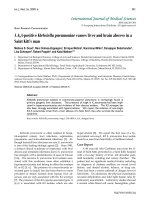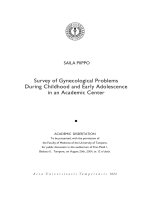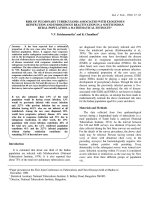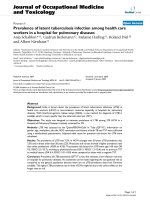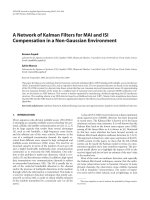Báo cáo y học: "Prevalence of Overactive Bladder, its Under-Diagnosis, and Risk Factors in a Male Urologic Veterans Population"
Bạn đang xem bản rút gọn của tài liệu. Xem và tải ngay bản đầy đủ của tài liệu tại đây (197.49 KB, 4 trang )
Int. J. Med. Sci. 2010, 7
391
I
I
n
n
t
t
e
e
r
r
n
n
a
a
t
t
i
i
o
o
n
n
a
a
l
l
J
J
o
o
u
u
r
r
n
n
a
a
l
l
o
o
f
f
M
M
e
e
d
d
i
i
c
c
a
a
l
l
S
S
c
c
i
i
e
e
n
n
c
c
e
e
s
s
2010; 7(6):391-394
© Ivyspring International Publisher. All rights reserved
Research Paper
Prevalence of Overactive Bladder, its Under-Diagnosis, and Risk Factors in
a Male Urologic Veterans Population
Wellman W Cheung
1
, William Blank
1
, Dorota Borawski
1
, William Tran
1
, Martin H Bluth
2
1. SUNY Downstate Medical School, Department of Urology, Brooklyn, NY, USA
2. Wayne State University School of Medicine, Department of Pathology , Detroit, MI, USA
Corresponding author: Wellman W Cheung, MD, SUNY Downstate Medical Center, Departments of Urology and Ob-
stetrics/Gynecology, 450 Clarkson Avenue, Brooklyn, NY 11230. Email:
Received: 2010.04.04; Accepted: 2010.09.09; Published: 2010.11.12
Abstract
Purpose: We assess the prevalence of overactive bladder (OAB) a n d i t s r i s k f actors i n a m a l e
urologic veterans population. Materials and Methods: Validated self-administered question-
naire was prospectively given. Results: Among 1086 patients, OAB was present in 75%, of
which 48% had not been diagnosed/treated. The risk of OAB increased with age. OAB was
not associated with BMI, smoking, race, diabetes, CHF, and COPD. Conclusions: The pre-
valence of OAB in this population is under-diagnosed and under-treated.
Key words: overactive bladder, OAB, incontinence, male, urology, veterans
INTRODUCTION
Recent international population and
non-population studies reported overactive bladder
(OAB) in 10-17% of the adult population, depending
on sex.
1,2,3,4
In the U.S., a population-based study re-
ported that 16.0% of men and 16.9% of women expe-
rienced OAB.
5
No study has examined the prevalence
of OAB in the urologic population, which is expected
to be much higher. Some studies have reported asso-
ciation of OAB with age (men and women), body
mass index - BMI (female), menopause (female), con-
stipation (female), episiotomy (female), and beer
consumption (men).
2, 6,7,8
In this prospective cohort study, we assess the
prevalence of OAB in urologic male veterans popula-
tion, the need for OAB screening, and risk factors for
OAB.
METHODS
An IRB-approved self-administered question-
naire on urinary symptoms was given to male pa-
tients who visited the general urology outpatient
clinic at a Veterans Administration hospital in
Brooklyn, NY. It included questions on lower urinary
tract symptoms (LUTS) with 0-5 point scale and on
quality of life with 0-6 (best to worst) point scale
(based on a modified validated Overactive Bladder
8-question Screener (OAB-V8)
9
). Questions on LUTS
included urinary frequency (2 questions), urgency (2),
nocturia (1), incontinence (2) and emptying (1). The
questionnaire also included medical and surgical
history, demographic data, BMI, medications and
visit diagnosis.
OAB-V8 total score that was equal to or greater
than 6 for men was defined as OAB positive. Subse-
q u e n t questionnaires from the same patient were ex-
cluded.
To determine the relationship between OAB and
other factors (age, BMI, smoking, race, diabetes,
hypertension, congestive heart failure, chronic ob-
structive pulmonary disease, diuretic medications
and hepatitis), covariates were first individually eva-
luated using the chi-square test. Statistically signifi-
cant (p < .05) covariates were retained for odds ratio
Int. J. Med. Sci. 2010, 7
392
analysis. Patients were excluded from a specific anal-
ysis if they did not report on the variable to be ana-
lyzed. Results are presented as odds ratio and 95%
confidence interval (95% CI)
10
. Statistical analyses
were performed using Stata 8.2 (StataCorp, College
Station, TX).
RESULTS
Among the male patients, 1086 completed the
questionnaire. Table 1 summarizes the demographic
data. Mean age was 68 years old (quartile range:
59-77). The major ethnicities were European American
(44%), African American (37%) and Hispanic Ameri-
can (11%).
Table 1. Demographics
O A B w a s p r e s e n t i n 7 5 % . A m o n g t h o s e s u r v e y e d
with OAB, 48% had not been diagnosed with or
treated for OAB, LUTS or benign prostatic hypertro-
phy (BPH). Those with OAB had a worse quality of
life score. Mean quality of life score for those with
OAB was 3.4 of 6, and those without OAB 1.6. Fur-
thermore, 59% reported urge incontinence, 76% ur-
gency, 90% frequency and 85% nocturia.
There was no association of OAB with BMI
(p=0.61), smoking (p=0.87), race (p=0.32), diabetes
(p=0.83), hypertension (p=0.10), congestive heart
failure (p=0.74), chronic obstructive pulmonary dis-
ease (p=0.69), and diuretic medications (p=0.91). The
risk of OAB increased with age: 49% in men aged
40-49 years to 79% in men aged 70-79 years (p<0.001,
OR=3.9). Interestingly, there was a statistically signif-
icant association between OAB and hepatitis (p=0.03,
OR=2.2). See Table 3.
Table 2. Prevalence of OAB, LUTS and OAB subtypes.
DISCUSSION
The prevalence of OAB in men has been reported
to be 10.2-16.0%. It is expected to be much higher in
the urologic setting since urinary complaint is a
common reason for urologic visit. Our study found
that 75% of those surveyed, experienced OAB. This is
almost five fold higher than that reported for the
general population. Since OAB is a compilation of
lower urinary tract symptoms, the prevalence of
LUTS should be higher. Irwin et al.
2
in their 5-country
population study reported the prevalence of any
LUTS to be 62.5% whereas the prevalence of OAB to
be 10.8%. Our study found that 95% reported urinary
frequency and 85% nocturia. The increase in our
study is consistent with Irwin et al.’s epidemiologic
study.
Although a higher prevalence of OAB is ex-
pected in our study population, the increase may also
be compounded by variation in OAB definition. M os t
Characteristics, n (%) Male
Age, years
number %
<30 8 1%
30-39 16 1%
40-49 49 5%
50-59 197 18%
60-69 274 25%
>
70
504 46%
Not stated 38 3%
Race
African American 404 37%
Hispanic 119 11%
White 477 44%
Asian 1 0.1%
Other 10 1%
Not stated 75 7%
Education
Less than high school 71 7%
High school graduate 614 60%
Some college/college graduate 293 29%
Graduate school 69 7%
Not stated 39 4%
Body mass index (BMI, kg/m
2
)
<25 191 18%
25-29.9 363 33%
>30 335 31%
Not stated 197 18%
History of smoking
Smoker 180 17%
Ex-smoker (stopped >
6 mths)
458 42%
Never 251 23%
Not stated 197 18%
Previous surgery
Bladder surgery 28 3%
Urinary leakage surgery 3 0.3%
Prostate surgery (RRP) 40 4%
Prostate surgery (non-RRP) 118 11%
Int. J. Med. Sci. 2010, 7
393
reported population studies had used the 2002 Inter-
national Continence Society definition of OAB. Our
study is based on a validated OAB screener ques-
tionnaire (OAB-V8). As with any screening tool, the
sensitivity should be high but specificity may not be
high. The O A B -V8 questionnaire has only been vali-
dated in a primary care setting. Validation in a high
risk population is still pending.
Our study showed that among those with OAB,
only 52% had been diagnosed with or treated for
urinary symptoms (OAB, LUTS and/or BPH). Fur-
thermore, those with OAB had a worse quality of life
score. Mean quality of life score for those with OAB
was 3.4 of 6, and those without OAB 1.6. Thus, the
48% of men with OAB that are undiagnosed or un -
treated may benefit from better detection and treat-
ment initiation. The OAB-V8 questionnaire is a possi-
ble effective and fast screening tool.
Our study also examined the risk factors for
OA B i n m en. We found that OAB increased with age:
49% in men aged 40-49 years to 79% in men aged
70-79 years (p<0.001, OR=3.9). This is consistent with
previous epidemiologic studies. Our study also found
an association between OAB and hepatitis (OR=2.2,
p=0.03). It is uncertain how hepatitis relates to OAB.
As such additional epidemiologic studies are needed
in this regard. Unli ke pr evi o u s s t u d ies by Teleman et
al.
8
, w e f ou nd no association between OAB and BMI.
However, patients in that study were all female. We
also found no association with smoking, race, di-
abetes, hypertension, congestive heart failure, chronic
obstructive pulmonary disease, and diuretic medica-
tions.
Table 3. Risk factors for OAB.
Int. J. Med. Sci. 2010, 7
394
CONCLUSION
The prevalence of OAB in the male urologic
veterans is almost five fold higher than that reported
for the general population. OAB is under-diagnosed
and under-treated. This patient population may ben -
efit from routine screening. Furthermore, our study
shows that OAB is associated with age and a history
of hepatitis.
Conflict of Interest
The authors have declared that no conflict of in-
terest exists.
References
1. Temml C, Heidler S, Ponholzer A and Madersbacher S. Preva-
lence of the overactive bladder syndrom by applying the In-
ternational Continence Society Definition. Eur Urol 2005;
48:622.
2. Irwin D, Milsom I, Hunskaar S, Reilly K, Kopp Z, Herschorn S,
et al. Population-based survey of urinary incontinence, overac-
tive bladder, and other lower urinary tract symptoms in five
countries: results of the EPIC study. Eur Urol 2006; 50:1306.
3. Herschorn S, Gajewski J, Schulz J and Corcos J. A popula-
tion-based study of urinary symptoms and incontinence: the
Canadian Urinary Bladder Survey. BJU Int 2008; 101:52.
4. Milsom I, Abrams P, Cardozo L, Roberts RG, Throff J and Wein
A. How widespread are the symptoms of an overactive bladder
and how are they managed? A population-based prevalence
study. BJU Int 2001; 87:760.
5. Stewart W, Rooyen JV, Cundiff G, Abrams P, Herzog S, Corey
R, et al. Prevalence and burden of overactive bladder in the
United States. J Urol 2003; 20:327.
6. Dallosso HM, Matthews RJ, McGrother CW, Donaldson MM,
Shaw C and Leicestershire MRC. The association of diet and
other lifestyle factors with the onset of overactive bladder: a
longitudinal study in men. Public Health Nutr 2004; 7:885.
7. Zhang W, Song Y, He X, Huang H, Xu B and Song J. Prevalence
and risk factors of overactive bladder syndrome in Fuzhou
Chinese women. Neurourol Urodyn 2006; 25:717.
8. Teleman PM, Lidfeldt J, Nerbrand C, Samsioe G, Mattiasson A
and WHILA study group. Overactive bladder: prevalence, risk
factors and relation to stress incontinence in middle-aged
women. BJOG 2004; 111:600.
9. Coyne K, Margolis M, Zyczynski T, Elinoff V and Roberts RG.
Validation of an OAB screener in a primary care patient popu-
lation in the US; Poster. Paris, France: International Continence
Society Annual Meeting. 2004.
10. Cheung WW, Khan NH, Choi KK, Bluth MH, Vincent M. Pre-
valence, evaluation and management of overactive bladder in
primary care. BMC Family Practice 2009;10:8



